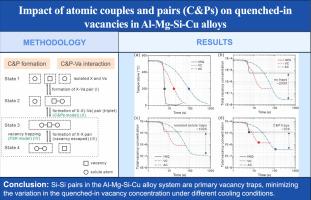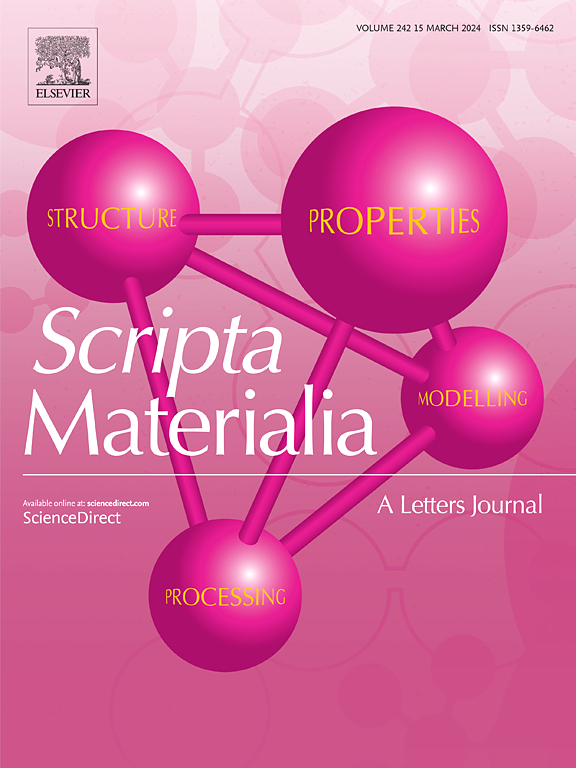原子偶和原子对Al-Mg-Si-Cu合金中淬火空位的影响
IF 5.6
2区 材料科学
Q2 MATERIALS SCIENCE, MULTIDISCIPLINARY
引用次数: 0
摘要
Al-Mg-Si-Cu合金在冷却速率相差约200倍的条件下固溶淬火后,用正电子湮灭寿命谱法测定的淬火空位浓度差仅为30倍左右。这与最近开发的FSAK模型预测的位错边界和晶界空位产生和湮灭的预期相差约200倍。为了解决这一差异,我们研究了原子对和原子对(C&Ps)对猝灭空位浓度的影响。将C&;Ps形成动力学和空位俘获相结合的理论框架应用于Al-Mg-Si-Cu合金。结果表明,Al-Mg-Si-Cu合金中的Si-Si对在淬火过程中充当主要的空位陷阱,比孤立溶质捕获更多的空位。模拟令人满意地解释了实验测量到的猝灭空位浓度差异约30倍,而在C&;Ps上没有空位捕获时预测的差异要大得多。本文章由计算机程序翻译,如有差异,请以英文原文为准。

Impact of atomic couples and pairs on quenched-in vacancies in Al-Mg-Si-Cu alloys
After solutionizing and quenching of Al-Mg-Si-Cu alloys at cooling rates differing by a factor of about 200, the quenched-in vacancy concentration difference as measured by positron annihilation lifetime spectrometry is only about 30 times. This contradicts the expected ∼200 times difference predicted by the recently developed FSAK model for vacancy generation and annihilation at dislocation jogs and grain boundaries. To address this discrepancy, we investigate the influence of atomic couples and pairs (C&Ps) on the quenched-in vacancy concentration. A combined theoretical framework incorporating C&Ps formation kinetics and vacancy trapping is developed and applied to an Al-Mg-Si-Cu alloy. The results indicate that Si-Si pairs in Al-Mg-Si-Cu alloys act as primary vacancy traps during quenching, capturing significantly more vacancies than isolated solutes. The simulations satisfactorily explain the experimentally measured ∼30 times difference in quenched-in vacancy concentration compared to the much larger difference predicted in the absence of vacancy trapping on C&Ps.
求助全文
通过发布文献求助,成功后即可免费获取论文全文。
去求助
来源期刊

Scripta Materialia
工程技术-材料科学:综合
CiteScore
11.40
自引率
5.00%
发文量
581
审稿时长
34 days
期刊介绍:
Scripta Materialia is a LETTERS journal of Acta Materialia, providing a forum for the rapid publication of short communications on the relationship between the structure and the properties of inorganic materials. The emphasis is on originality rather than incremental research. Short reports on the development of materials with novel or substantially improved properties are also welcomed. Emphasis is on either the functional or mechanical behavior of metals, ceramics and semiconductors at all length scales.
 求助内容:
求助内容: 应助结果提醒方式:
应助结果提醒方式:


